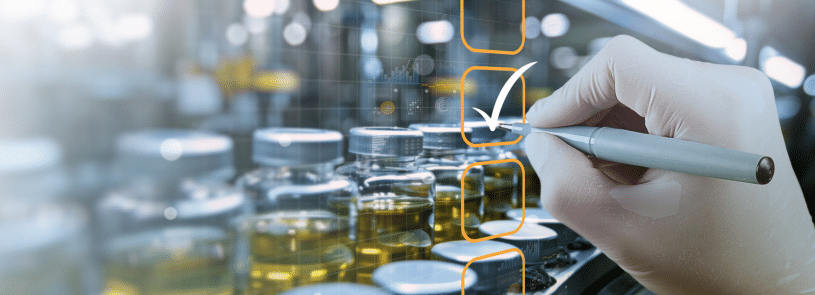Quality Control in the (Bio)Pharmaceutical Industry: Safeguarding Medicines for Global Health

In the pharmaceutical industry, the stakes for producing high-quality products are unparalleled. Medicines, whether traditional small molecules or advanced biologics, can save lives, prevent diseases, and improve quality of life. However, rigorous Quality Control (QC) processes are crucial to ensure their safety and efficacy. This article explores what QC is, why it’s vital in the (bio)pharmaceutical industry, how QC varies across product types, and what trends are shaping its future.
What is Quality Control in the (Bio)Pharmaceutical Industry?
Quality Control refers to a set of processes and tests designed to ensure that a product meets predefined safety, efficacy, and quality standards before it reaches the patient. In the context of pharmaceuticals, QC ensures that drugs are safe for human use, meet regulatory requirements, and maintain consistent therapeutic benefits.
QC involves:
- Sampling: Taking small quantities of the product at various production stages.
- Testing: Conducting chemical, physical, biological and microbiological analyses to verify compliance with product specifications.
- Documentation: Accurately record and review results to meet regulatory standards.
For (bio)pharmaceuticals, QC spans multiple stages of the product lifecycle, from raw materials to finished products. In essence, it is the industry’s safeguard against defects that could compromise public health.
Why Do We Need Quality Control in Pharmaceuticals?
Pharmaceutical products are unique in their potential to impact health positively or negatively. A contaminated, improperly dosed, or unstable drug can cause severe harm or even death. QC is essential for several reasons:
1. Ensuring Patient Safety
Errors in drug production, such as contamination with harmful microbes or incorrect dosage, pose significant risks to patients. QC ensures these errors are detected and corrected before the product reaches consumers.
2. Regulatory Compliance
Regulatory agencies such as the U.S. Food and Drug Administration (FDA), European Medicines Agency (EMA), and others mandate stringent QC protocols. Non-compliance can lead to costly recalls, fines, or the loss of manufacturing licenses.
3. Maintaining Public Trust
The (bio)pharmaceutical industry operates under intense scrutiny. A single quality failure can wear down public confidence in a company or the industry. QC is central to upholding trust.
The Importance of QC: Lessons from History
Several historical incidents underscore the critical role of QC in the pharmaceutical sector:
- The Elixir Sulfanilamide Tragedy (1937): A toxic solvent used in an antibiotic caused over 100 deaths, leading to the establishment of modern drug safety regulations.
- Thalidomide (1956 – 1960): Thalidomide was widely prescribed to pregnant women with morning sickness and caused over 10,000 babies to be born with deformations in 46 countries. Testing and licensing regulations were tightened because of this, and post-marketing surveillance increased.
- Heparin Contamination (2007-2008): Contaminated batches of the blood-thinning drug heparin were linked to hundreds of adverse events and deaths. Improved QC protocols have since become mandatory for similar products.
- Valsartan Recalls (2018): A widely prescribed heart medication was found to contain carcinogenic impurities, resulting in global recalls and heightened regulatory scrutiny.
Each incident underscores how lapses in QC can have devastating consequences, reinforcing its importance.
Differences in Quality Control for Small Molecules, Proteins, and Advanced Therapies
The pharmaceutical landscape is evolving rapidly, encompassing traditional small molecules, biologics (e.g., proteins), and advanced therapies like cell and gene treatments. QC approaches must adapt to the unique characteristics of each product type. This table gives an overview of some of the key aspects and differences.
| Aspect | Small Molecules | Proteins and Biologics | Advanced Therapies (Cells & Gene Therapies) |
| Structure | Simple, well-defined chemical compounds. | Complex macromolecules with variable heterogenic structures. | Highly variable; patient-specific or genetically modified. |
| Production Source | Synthetic chemical reactions. | Produced using living cells (e.g., bacteria, yeast). | Derived from human cells or viral vectors. |
| Testing Complexity | Straightforward (e.g., HPLC, dissolution tests). | Advanced (e.g., protein characterization, bioassays). | Cutting-edge (e.g., flow cytometry, sequencing). |
| Stability | Stable under various conditions. | Sensitive to temperature and pH. | Extremely sensitive; often requires cryopreservation. |
| Batch Consistency | High uniformity across batches. | Moderate variability due to biological systems. | Highly variable, especially for personalized therapies. |
Small molecules are chemically synthesised drugs with relatively simple structures. Quality control (QC) for these products primarily focuses on ensuring purity by eliminating unwanted impurities from the chemical synthesis process. Stability testing is essential to verify that the drug maintains its integrity under various conditions. Additionally, dissolution testing assesses how quickly the drug dissolves in the body, ensuring bioavailability.
Biologics, including monoclonal antibodies and vaccines, are complex proteins produced using living cells. QC for biologics is more complicated due to their sensitivity to environmental conditions such as temperature, their heterogeneous structures that make consistency harder to achieve, and their susceptibility to contamination by viruses, bacteria, or cellular impurities. In addition to fundamental factors like purity, content, and stability, which remain essential, QC techniques for biologics include potency assays to check whether the biologic achieves its intended biological effect, sterility testing to ensure no microbial contamination and protein characterisation to analyse folding, glycosylation, and aggregation.
Emerging cell and gene therapies, such as CAR-T cell therapies, pose unique QC challenges. These therapies are personalised for individual patients, requiring customised QC protocols. Many cell therapies also have a short shelf life, necessitating immediate and precise QC tests, often before the final product is available. Furthermore, gene therapies are highly complex and involve advanced delivery systems like viral vectors, requiring cutting-edge QC techniques such as next-generation sequencing (NGS) to ensure quality control.
Implementing effective Quality Control (QC) in the (bio)pharmaceutical industry is crucial, but it comes with several challenges, especially with the rise of advanced therapies. These include:
1. Complexity of Advanced Therapies
New therapies, such as biologics, gene therapies, and cell-based treatments, require specialised testing methods, making QC more complex. Each therapy may also need tailored protocols, increasing the burden on QC systems.
2. High Costs
QC for biologics and gene therapies is resource-intensive, involving advanced technologies, specialised personnel, and extended testing periods. This drives up costs, challenging manufacturers to balance quality with affordability.
3. Regulatory Compliance
Keeping up with rapidly changing regulations is a significant challenge. New therapies often require updated or additional testing standards, and meeting global regulatory requirements adds complexity to QC procedures.
4. Batch-to-Batch Variability
Ensuring consistent quality across large-scale production of biologics or gene therapies is difficult due to inherent variability in living systems. This requires real-time monitoring and more extensive testing to guarantee batch consistency.
5. Storage and Stability Issues
Many biological therapies require specialised storage and have short shelf lives. QC must account for maintaining product integrity under stringent conditions and throughout the distribution chain.
Trends Shaping Quality Control in the (Bio)Pharmaceutical Industry
QC in the (bio)pharmaceutical sector is evolving rapidly, driven by technological advancements, regulatory changes, and the growing complexity of therapies.
1. Automation and Digitalization
Automation reduces human error and enhances reproducibility in QC processes. High-throughput screening systems, robotic arms, and automated documentation systems are becoming standard in many labs. Additionally, digital tools like electronic batch records ensure data integrity.
2. Advanced Analytical Techniques
Innovative methods such as mass spectrometry, spectroscopy, and NGS allow for more precise QC in complex biologics and gene therapies. These techniques improve sensitivity and enable real-time monitoring of production.
3. Regulatory Harmonization
Globalisation has encouraged efforts to harmonise QC standards across regions. Initiatives like the International Council for Harmonisation (ICH) streamline regulatory expectations, enabling smoother global distribution.
4. Sustainability
Green chemistry and sustainable practices are gaining traction in QC labs. For instance, microfluidics-based assays (like capillary electrophoresis) reduce reagent consumption and waste, aligning with environmental goals.
5. Artificial Intelligence (AI) and Machine Learning
AI algorithms analyse QC data to predict manufacturing issues before they occur. Machine learning models can optimise testing protocols, reducing costs and improving efficiency.
6. Real-Time Release Testing (RTRT)
RTRT enables products to be released to market immediately after production, based on continuous QC monitoring rather than end-stage testing. This approach accelerates manufacturing timelines, especially for critical therapies like vaccines.
Conclusion: The Future of QC in Pharmaceuticals
Quality Control is the backbone of the (bio)pharmaceutical industry, ensuring that life-saving medicines are safe, effective, and reliable. As therapies grow more complex, QC processes must evolve, incorporating cutting-edge technologies and innovative approaches. By prioritising robust QC, the industry protects patients and upholds its mission to improve global health.
Looking ahead, QC will likely continue to emphasise automation, sustainability, and highly accurate and specific testing to meet the challenges posed by next-generation therapies. In a world where health crises can emerge unexpectedly, the importance of rigorous QC has never been more evident.
Related Content
Advertisement


